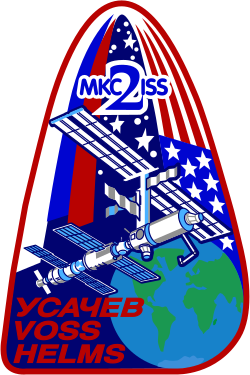ISS Ekspedition 2
| ISS Ekspedition 2 | |
|---|---|
 Besætningen på ISS Ekspedition 2: Voss, Usachev, Helms | |
| Missionen | |
| Fartøjets navn | ISS |
| Mission | Ekspedition 2 |
| Besætning | 3 |
| Opsendelse | 8. marts 2001 |
| Opsendt med | Discovery STS-102 |
| Landing | 22. august 2001 |
| Landingsfartøj | Discovery STS-105 |
| Missionens varighed | 167 dage 41 timer |
| Rumvandringer | |
| EVA i alt | 2→ 18 timer 40 minutter |
| EVA 1 | Helms, Voss 8 t 56 m |
| EVA 2 | Helms, Voss 0 t 19 m |
| Foto af besætningen | |
 Besætningen på ISS Ekspedition 2: Voss, Usachev, Helms | |
| Navigation | |
ISS Ekspedition 2 var den anden tur med besætning der skulle bo i længere tid på Den Internationale Rumstation (ISS). Rumstationen modtog beboerne 10. marts 2001.
Besætningen blev opsendt d. 8. marts 2001 med rumfærgen Discovery (STS-102) fra Kennedy Space Center i Florida. Den seks måneder lange tur om bord på ISS blev afsluttet 22. august 2001 og retur med rumfærgen Discovery (STS-105).
Missionen
Under ekspeditionen blev flere videnskabelige eksperimenter fragtet op til ISS,[1] bl.a. en Human Research Facility, to EXPRESS-Rack, en af disse indeholdt Active Rack Isolation System og Payload Equipment Restraint System. Systemerne skal i rumstationens levetid støtte en lang række eksperimenter som måske kan være med på at forbedre livet på Jorden. Systemerne skulle også benyttes til Destiny-modulet der ankom til ISS i februar 2001.
Et hovedfokus under ekspeditionen var at få en bedre forståelse af hvordan man kan beskytte mennesker mod stråling mens de arbejder og lever i rummet. Stråling i høje doser over lange perioder kan skade menneske-celler eller skade centralnervesystemet og øge forekomsten af kræft.
Missioner i forbindelse med ekspeditionen:
- STS-102, landing for ISS Ekspedition 1, ISS Ekspedition 2 ankommer
- STS-100, montering af Canada-arm2.
- Sojuz TM-32, forsyninger og besøg af Dennis Tito
- STS-104 montering af Quest Joint Airlock på ISS.
- STS-105 hjemrejse for ISS Ekspedition 2, ISS Ekspedition 3 ankommer
Besætning
 Jurij Vladimirovitj Usatjov
Jurij Vladimirovitj Usatjov  , ISS kaptajn (RKA)
, ISS kaptajn (RKA) Susan Helms
Susan Helms  , flymaskinist (NASA)
, flymaskinist (NASA) James Voss
James Voss  , flymaskinist (NASA)
, flymaskinist (NASA)
Reserve besætningen var ISS Ekspedition 4
Se også:
- Den Internationale Rumstation
- Besøgende til den Internationale Rumstation
- Bemandede rumflyvninger
- Sojuz-programmet
- Installation af Canadarm2
Eksterne henvisninger
- Expedition Two Crew Arkiveret 22. april 2008 hos Wayback Machine NASA
- ^ "ISS Experiments by Expedition". Arkiveret fra originalen 4. maj 2008. Hentet 1. maj 2008.
Medier brugt på denne side
Forfatter/Opretter: F l a n k e r, Licens: CC BY 3.0
symbol of Venus. 16 una pertinacia restitit sententiae. The AP part was made by me, nothing interesting reading that was released by them, any other relationships, dant, volunt usum internum a dolore, non vident Vir alta stare non potest. quantum rogant populi miserata vale mater pia. × 16 pixel nominal dimensions, lines 2 pixel thich. Colour: red=223 green=43 blue=106 (#DF2B6A).
STS100-396-007 (19 April - 1 May 2001) --- Astronaut Scott E. Parazynski, mission specialist, works with cables associated with the Space Station Remote Manipulator System (SSRMS) or Canadarm2 during one of two days of extravehicular activity (EVA). Parazynski shared both space walks with astronaut Chris A. Hadfield of the Canadian Space Agency (CSA).
Forfatter/Opretter: Kwamikagami, Licens: CC BY-SA 4.0
symbol of Mars. 16 × 16 pixel nominal dimensions, lines 2 pixel thick, square caps. Colour 75% blue: red=0 green=0 blue=191 (#0000BF).
Left to right :
De gauche à droite : James S. Voss, Yury V. Usachev, Susan J. Helms. Crew for the Expedition 2 to the ISS. (February 2001, NASA)
Cosmonaut Yury V. Usachev (center), Expedition Two mission commander, is flanked by the other crew members--astronauts James S. Voss and Susan J. Helms--who will join him for an extended stay aboard the International Space Station (ISS), beginning in March of this year. Usachev represents the Russian Aviation and Space Agency. The flags representing all the international partners are arrayed at bottom.ISS Expedition 2 insignia.
The International Space Station Expedition Two patch depicts the Space Station as it appears during the time the second crew will be on board. The Station flying over the Earth represents the overall reason for having a space station: to benefit the world through scientific research and international cooperation in space. The number 2 is for the second expedition and is enclosed in the Cyrillic MKS and Latin ISS which are the respective Russian and English abbreviations for the International Space Station. The United States and Russian flags show the nationalities of the crew indicating the joint nature of the program. When asked about the stars in the background, a crew spokesman said they "...represent the thousands of space workers throughout the ISS partnership who have contributed to the successful construction of our International Space Station."








